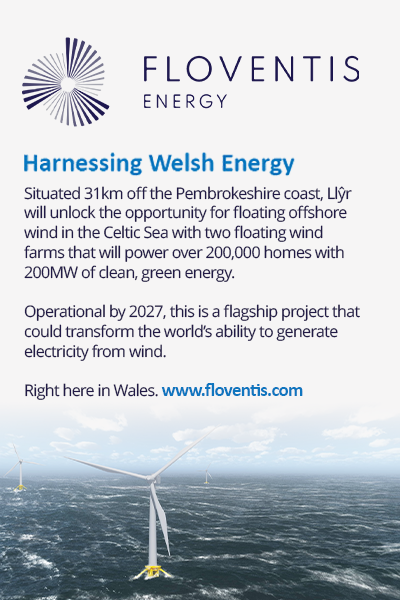Plans for a new generation of floating wind farms off the coasts of Wales and South West England moved a step closer as the leasing round for three sites in the Celtic Sea entered its final stages.
The Crown Estate – which manages the seabed around Wales. England, and Northern Ireland –also revealed that, as part of the process, companies bidding to build the new wind farms shortlisted a range of potential locations in Wales and South West England for the assembly and deployment of the new turbines.
In February 2024, The Crown Estate embarked on a new leasing round for three areas of seabed off the coasts of Wales and South West England. Known as Offshore Wind Leasing Round 5, the process is expected to award rights for three new floating wind farms in the Celtic Sea, capable of generating enough new renewable energy capacity to power more than four million homes (up to 4.5 gigawatts). The leasing round follows more than three years of engagement with a range of stakeholders including UK and Welsh Governments, industry, environmental bodies and other users of the seabed to identify the best locations for the new wind farms and inform the approach to the leasing round.
As part of the process, bidders have submitted proposals for developing the new wind farms, alongside plans for creating new opportunities for jobs and economic regeneration and working with ports.
Evaluation of these proposals from the first stage of the tender (known as ITT Stage 1) has now concluded, with successful bidders invited to progress to the final stage (ITT Stage 2). This will involve an auction for the three sites later in the spring. Winning bidders are then expected to sign Agreements for Lease this summer.
Research published last year by The Crown Estate showed these new wind farms could support the creation of more than 5,000 jobs and deliver a £1.4 billion boost to the economy, with further opportunities through the supply chain.
The Crown Estate, which exists to create lasting and shared value from its activities for the benefit of the nation, has made securing new onshore jobs and opportunities a cornerstone of its approach to this latest leasing round. It has also invested significantly in reducing some of the risks faced by developers, including activities such as marine surveys of the proposed sites and working with NESO to provide early visibility of designs for connecting the new wind farms to the UK’s energy grid.
As part of their bid proposals, bidders have set out which ports they intend to work with to support the delivery of projects if they are successful. This refers specifically to ‘integration ports’ where turbines will be mounted on large floating platforms before being towed out to sea. Detailed discussions between individual ports and winning bidders are expected to begin following the conclusion of the tender process. The development of ports to support the new wind farms is expected to lead to the creation of significant new opportunities for jobs and economic growth.
The turbines could be as much as 300 metres tall, around the same height as The Shard in London, and sit on a floating platform similar in size to a football pitch.
Bidders have put forward a range of ports at this stage which are in relative proximity to the Celtic Sea. These are:
- Pembroke Port (Port of Milford Haven)
- Port of Swansea
- Port Talbot
- Port of Bristol
- Port of Plymouth
- Falmouth Port
- Port of Brest
The Crown Estate said that at this stage, the information provided by bidders indicates a strong potential for Port Talbot and/or Port of Bristol to play a key role in the delivery of Round 5 projects.
The three sites available through Round 5 are expected to be the first phase of commercial development in the Celtic Sea. The Crown Estate’s Future of Offshore Wind report detailed plans to bring to market an additional 20-30 gigawatts of offshore wind leasing opportunity by 2030. It outlined spatial potential for up to 12 gigawatts of new capacity in the Celtic Sea (beyond Round 5), of which 4-10 gigawatts could be leased by 2030 through future leasing rounds.
Gus Jaspert, Managing Director, Marine at The Crown Estate, said:
“The advent of floating offshore wind offers a generational opportunity for the UK to be at the forefront of an exciting new global industry. Developing this new technology in the Celtic Sea will open up transformational opportunities for new jobs, investment and growth across Wales, South West England and beyond.
“With Government backing to secure the long-term success of the UK as a global leader in floating wind, we can lay the foundations for future generations to reap the rewards of a decarbonised, energy-secure and prosperous future.
“We look forward to continuing our work with governments and the industry to secure the investment and commitment needed as we move forward, for the benefit of coastal communities and the UK as a whole.”
Energy Secretary Ed Miliband said:
“The UK is a world leader when it comes to floating offshore wind, and by unlocking the untapped potential of the Celtic Sea we will reap the benefits of economic growth and thousands of jobs in Wales and the South West, delivering on our Plan for Change.
“Since taking office, we have approved the world’s largest floating offshore wind farm project, and we are backing the industry even further so this cutting-edge technology can continue to thrive off the UK coastline.
“More floating turbines in our waters means more clean, homegrown power that we control, delivering energy security for families and businesses.”
UK Government Business Secretary Jonathan Reynolds said:
“The UK is open for business, and this leasing round will help unlock vital new investment in our world-leading floating offshore wind industry to create jobs and prosperity in our coastal communities.
“Backed by our Industrial Strategy, which will place the clean energy sector at the heart of our growth plans, we’re driving forward our missions to make the UK a clean energy superpower and secure economic growth – delivering on two of the foundations of our Plan for Change.”
Cabinet Secretary for Economy, Energy and Planning, Rebecca Evans, said:
“This milestone represents a significant opportunity for Wales. Floating offshore wind in the Celtic Sea will not only advance our clean energy goals but create valuable jobs and investment across Wales’ coastal communities. Our ports are well positioned to support this growing industry and we're committed to ensuring such developments deliver lasting economic benefits for Wales whilst continuing to strengthen our position as a renewable energy leader.”
RenewableUK's Deputy Chief Executive Jane Cooper said:
“We welcome this step forward towards the crucial final stages of this landmark leasing round which will kickstart the industrial development of floating offshore wind projects and supply chains at scale in the UK. Today's announcement on the ports which could host new wind turbine assembly facilities will provide confidence for investors in port facilities around the country, including those in south Wales and the south west of England who are focussing on new floating windfarms in the Celtic Sea.
“By 2050, floating turbines could provide a third of the UK’s offshore wind capacity with 40 gigawatts fully operational – enough to power every home in the country. By then, our analysis shows that the UK’s floating wind industry will employ 97,000 people, contributing £47 billion to our economy by building and supplying projects here as well as exporting our cutting-edge technology worldwide. Maximising the capacity of floating wind to be delivered in future leasing rounds would enable the UK to make the most of these exciting opportunities.”
Richard Ballantyne, Chief Executive of the British Ports Association, said:
“Floating offshore wind will bring jobs and prosperity to UK shores, whilst moving us closer to net zero. Ports are critical to securing the social and economic benefits of the energy transition and we welcome this step forward in making floating wind a reality in UK waters. As an industry we will continue to work closely with Government, The Crown Estate and the renewable energy sector to deliver on our shared ambitions for offshore wind.”





